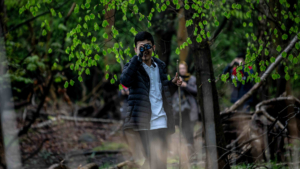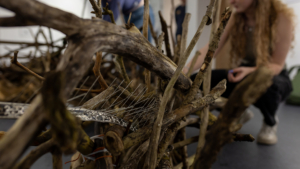- Posted on October 28th, 2025
Lintukoto: Nests of Belonging

The Creative Climate Accelerator is a training programme by JB and Arts Council England, designed to empower emerging climate leaders from diverse backgrounds within the cultural sector. Participants develop action plans for creative climate projects, focusing on themes like climate justice and biodiversity.
Finnish artist Henna Asikainen’s project Lintukoto explores the interconnections between migration, climate change, and belonging through participatory, nature-based artmaking that invites displaced communities to reimagine ideas of home and sanctuary alongside the natural world.
In this case study, I reflect on my ongoing, participatory arts project called Lintukoto which explores the deeply entangled themes of migration, climate change, belonging, hospitality and displacement of both human and more-than-human lives, through the lens provided by migratory birds – their habits, their lives, and the nests they build.
The project draws its name from Finnish folklore – lintukoto which refers to a mythical, paradise like haven at the far edge of the world, where birds were believed to migrate to escape the harshness of winter. I have reimagined this concept within the context of our current moment, considering the idea of lintukoto through the lens of forced displacement, climate change and the manifold violences of the Anthropocene.
Lintukoto is an ongoing, co-creative project involving people from a range of backgrounds, with a particular focus on those with lived experience of forced migration and seeking asylum. It brings together arts, heritage, and science partners in a collaborative effort to bring forth the voice of those often excluded from climate discourse, cultural spaces and natural environments such as national parks and nature reserves.
The project’s conceptual framework encompasses nature-based methodology that supports meaningful integration with and within nature. By engaging participants in collective nature-based exploration and making, the project responds to calls for reimagining integration and migration policies through an eco-social lens – one that recognises environmental justice and social inclusion as deeply interconnected and mutually reinforcing.

The nature-based engagement programme draws from my own experience of migration and how experiencing the landscape and nature surrounding my adopted home city, helped me to put down roots and to begin to feel little more at home. In my experience, landscapes and the nature, provides a psychological and emotional link between a country of origin and an adopted country even when they present very different characteristics. Nature is our first host without which no home can be built.
Through nature-based creative workshops – such as nest building – and visits to nature reserves and parks, the project opens up space to imagine new forms of sanctuary and solidarity in a time of crisis.
By facilitating access to nature reserves, woodlands, and parks, Lintukoto connects participants with landscapes that many may not have previously felt welcome or entitled to explore. These spaces become more than backdrops; they are active components of the project’s meaning. Nature is not neutral – access to it is political, and the ability to feel at home in it is a right often unequally distributed.
The art work – public outcome

The artwork takes inspiration from the behaviours of migratory birds – especially their patterns of movement and nest-building to explore themes of displacement, care, adaptation, and interdependence. Birds’ nests are evocative metaphors for many things – home, belonging, protection and sustainability which formed a poignant and accessible metaphor around which to situate the project. Despite their temporary nature, nests are invested with care; intricate, beautiful, protective structures. Each species has its own construction methods, favouring certain materials but always constructed from what is available locally.
These magical architectural creations, abandoned by the end of the summer, invite us to reflect upon the nature of home – questions about both the temporality of home and its endurance, about our own investment in home – its life-affirming qualities – what it means to be without a home, to be at home, and to journey away from it.
The first public outcome of the project was an exhibition at the Peter Scott Gallery at Lancaster Arts (March – May 2025). Rather than a traditional private view, the public was invited to participate in an embodied, collective act of nest-building: a large human-scale nest constructed together in the gallery space.
The exhibition at Lancaster Arts marked an important public milestone for the Lintukoto project. However, the project remains very much ongoing. The next phase will unfold an exhibition at the NewBridge Gallery in Newcastle, opening in October 2025. This upcoming iteration will take a distinctly different form, offering a new way for audiences to engage with the work. Without revealing too much just yet, this version will move away from collective nest-building and instead take shape as a multi-channel audio installation – a climigration archive that brings together layered voices, sounds, and stories.
Project partners include the Great North Museum: Hancock, The Natural History Society of Northumbria, Lancaster Arts and The NewBridge Project. Project is generously supported by Arts Council England Project Grant and The Finnish Institute in UK and Ireland.
Header image: Lintukoto Nature Reserve Visit and walk, photo by Simonen Rudolphie
